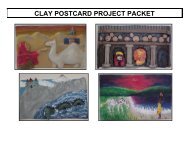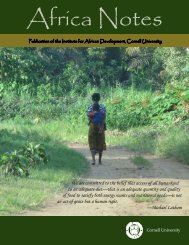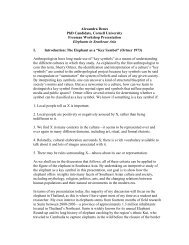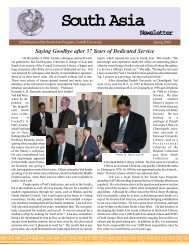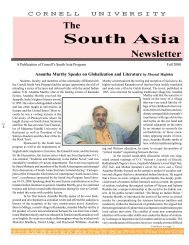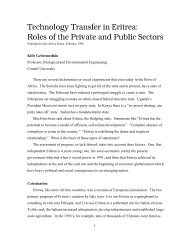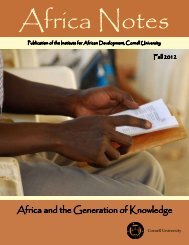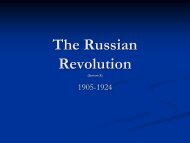Fall 2002 - South Asia Program - Cornell University
Fall 2002 - South Asia Program - Cornell University
Fall 2002 - South Asia Program - Cornell University
You also want an ePaper? Increase the reach of your titles
YUMPU automatically turns print PDFs into web optimized ePapers that Google loves.
OUTREACHBeneath the Banyan Tree: An Exhibit of Indian Art and Paintings by Anne StengleIf you will be anywhere near Syracuse, NY from November 17, <strong>2002</strong> January 6,2003, do not miss this wonderful exhibition, Beneath the Banyan Tree: Ritual,Remembrance, and Storytelling in Performed North Indian Folk Arts. Presentedby the Lowe Art Gallery, in collaboration with the <strong>South</strong> <strong>Asia</strong> Center at Syracuse(our consortium partner for funding as a National Resource Center) and the MaxwellSchool of Citizenship and Public Affairs, this exhibition focuses on four major formsof performed North Indian folk art that capture the intersection of ritual, performanceand art in the living traditions of North India.The art forms include:(1) terracotta and brass (cire perdue) sculptures that represent the deities and serveas offerings to them;(2) pata, storytelling scrolls made and performed in West Bengal;(3) women’s paintings from the Mithala region of Bihar, which create auspiciousness for their life cycle rituals and tell the stories of thegods and goddesses that enliven lives there;(4) Rajasthani par, or large scrolls which are used by singers to tell epic stories in the western state of Rajasthan.The exhibition is open to the public from November 17, <strong>2002</strong> January 6, 2003 at the Joe and Emily Lowe Art Gallery on the Syracuse<strong>University</strong> campus. Hours of the exhibition are: Tuesday Sunday 12:00 5:00PM; Wednesday 12:00 8:00PM.Tours for school groups may be arranged with the <strong>South</strong> <strong>Asia</strong> Center by e mailing: southasia@maxwell.syr.eduFor further information and for special information for teachers, please visit http://www.maxwell.syr.edu/gai/south-asia-center/BanyanTree/BanyanHome.htmNew Speakers Bureau <strong>Program</strong> for Regional K - 8 EducatorsThe <strong>South</strong> <strong>Asia</strong> <strong>Program</strong> is pleased to announce a new outreach endeavor in collaboration with the <strong>South</strong>east and East <strong>Asia</strong>programs at <strong>Cornell</strong> targeted at elementary and middle schools. The <strong>Asia</strong> Speakers Bureau program supports a variety of activitiesincluding organized trips to local museums and the development of on line teaching resources, but particular attention is paid toclassroom activities. These in class presentations offer our faculty and students the opportunity to share their knowledge of <strong>Asia</strong> withyoung children and further support New York State curriculum guidelines for social studies, language arts and science. Additionally, thispan <strong>Asia</strong> program has brought togther local third and sixth grade educators to serve as an advisory panel. This panel is currentlyidentifying and evaluating elementary and middle school resource needs for teaching about <strong>Asia</strong>. Curricula will be developed andpresented at an upcoming teacher training workshop. If you are an elementary or middle school teacher in central New York and wish tohave an in school presentation, please call Anne Stengle at 607 255 8493. Presentations are also readily available for ninth and tenth gradeclasses. See below for an excellent example for ninth grade global studies.<strong>Cornell</strong> Students Present Indian EpicsOn a snowy morning in early December, 9 th graders in Ms. Fitzsimmons’ global studies class at Watkins Glen High School weretreated to an excellent presentation of two famous Indian epics. <strong>Cornell</strong> sophomores Priya Rajasethupathy and Geetha Shanmugamcreated a wonderful program on the Ramayana and the Mahabharata. Beginning with a summary, Geetha presented the Ramayana andPriya explained the Mahabharata. As one spoke, the other further detailed the importance of the main characters and their relationships.Additionally, both talked about growing up in the Indian culture how certain parables from the epics are used to explain societal normsand expectations. After this, they had the students break up into groups. Each was given a scene from either the Ramayana or Mahabharataand asked to act it out as they thought it happened long long ago, or how it might look today. With only fifteen minutes of preparation,the groups did a delightful job with all members actively participating.The <strong>South</strong> <strong>Asia</strong> <strong>Program</strong> would like to send our most sincere thanks to Ms. Rajasethupathy and Ms. Shanmugam for their hardwork, and to Ms. Fitzsimmons for the opportunity to share these important works with her students.3
VISITORSDr. Habibul H. Khondker, SAP's Visiting Scholar, <strong>Fall</strong> <strong>2002</strong>The <strong>South</strong> <strong>Asia</strong><strong>Program</strong> would like towelcome it’s <strong>Fall</strong> <strong>2002</strong>visitor, Dr. Habibul H.Khondker, an AssociateProfessor from the National<strong>University</strong> ofSingapore’s Departmentof Sociology. Dr.Khondker is known forhis work in globalizationand development studies.In his research he has focusedon famine in Bangladesh(his country of origin),dealing with issues of hunger, inequality and governance.He is presently looking at democratization ona global scale, and has done comparative studies between<strong>South</strong> and <strong>South</strong>east <strong>Asia</strong>. He believes that lackof economic development in <strong>South</strong> <strong>Asia</strong> affects thequality of life and that there is not enough emphasis ongovernance or on true democratic values, which resultsin a tenuous democracy. In <strong>South</strong>east <strong>Asia</strong>, democracyis likely to grow out of economic development.Khondker is interested in using social scientific knowledgefor promoting peace. He is influenced by the humanitarianideals of Mahatma Gandhi and Martin LutherKing. He is also interested in the theories of NobleLaureate, Amartya Sen, a scholar from India whosework produced new understanding of the catastrophesthat plague society’s poorest people and has studiedthe Bangladesh famine of 1974. Sen’s idea of freedomas development has impacted Khondker’s recent workon the importance of genuine democratization, religioustolerance, and pluralism.Dr. Khondker gave two lectures this fall, What<strong>South</strong> <strong>Asia</strong> can learn from <strong>South</strong>east <strong>Asia</strong>, or is itthe other way around? The uneasy relationship betweendemocracy and governance for the <strong>South</strong>east<strong>Asia</strong>’s Brown Bag Lecture Series, and Constructionand Reconstruction of National Identity in Bangladeshfor the <strong>South</strong> <strong>Asia</strong> <strong>Program</strong>. He believes thatthe Internet can play a positive role in circulating thevoices of intellectuals on a global scale and that a globalcivil society should lay the foundation for a sustainableworld democracy. This is explained in his articleon the role of the Internet in Singapore (British Journalof Sociology). He has many other publications tohis credit. Habibul helps run a Bengali School inSingapore and often contributes as a guest journalistfor an English daily in Bangladesh. He enjoys cricketas much as Tagore songs in his spare time and considershimself a global citizen.Killing Terraces of Nepal shown at <strong>Cornell</strong> <strong>University</strong>by Sara Shneiderman4On June 4 th , <strong>2002</strong>, the <strong>Cornell</strong> Nepal Association hosted filmmaker Dhurba Basnetand Himal Association director Basanta Thapa for a special showing of Basnet’sfilm, “The Killing Terraces of Nepal”. Supported by the <strong>South</strong> <strong>Asia</strong> <strong>Program</strong>, Basnetand Thapa participated in a full day of events, including an extended open discussionon the Maoist movement and the current political situation in Nepal, a showing of thefilm, and a question-and-answer session afterwards. Presiding over the events wasKathryn March, Associate Professor of Anthropology, and director of the <strong>Cornell</strong>-Nepal Study <strong>Program</strong>. The open discussion, held in the afternoon, was attended byabout 25 <strong>Cornell</strong> students and Ithaca residents interested in Nepal, while close to 40attended the film showing. Both events were very successful, with Basnet and Thapaprovoking and answering thoughtful questions. Their visit concluded with a tandooridinner on the shores of Ithaca’s Cayuga Lake.Thapa and Basnet
FACULTY/COURSESSociety for Harappan Studies Meets at <strong>Cornell</strong>The Society for Harappan Studies met at <strong>Cornell</strong> Univerity during the period ofAugust 23 to 25, <strong>2002</strong>. The focus of the papers and discussions is prehistoricarchaeology and biological anthropology of the Indian subcontinent. The organizerand host was Kenneth A.R. Kennedy. There was a full day of paper sessions onthe Saturday morning and afternoon of the meeting, and this was followed bycocktails at the Kennedy house and dinner at the Antlers Restaurant. Among thosepersons present who presented papers were the Drs. Raymond and Bridget Allchinfrom the Ancient India and Iran Trust at Cambridge <strong>University</strong>, England, Dr. GregoryL. Possehl of the <strong>University</strong> of Pennsylvania, Mrs. Parveen Talpur of Ithaca, KennethA.R. Kennedy of <strong>Cornell</strong> <strong>University</strong>, and faculty and student visitors from other institutions. The Society was founded bythe late Dr. Walter Fairservis of Vassar College and now meets in alternate years at different localities in the northeast.The next meeting in August 2004 will be held in Manchester, Vermont, with Dr. Rita Wright as host. For further informationcontact Kenneth Kennedy at (607) 254-4214 or (607) 272-3936.New <strong>South</strong> <strong>Asia</strong> Courses for Spring '03ASIAN 438/638, RELST 438 : Monks, Texts andRelics: Transnational Buddhism in <strong>Asia</strong>, ProfessorAnne Blackburn Contact <strong>Asia</strong>n Studies for prerequisites.The course examines the ways in which <strong>Asia</strong>n Buddhistcommunities, especially in <strong>South</strong> and <strong>South</strong>east <strong>Asia</strong>, were(and perhaps still are) formed through the import-export ofmonks, texts, and relics, as part of a trade in “orthodoxy,”symbolic capital, and magical power. Tuesdays andThursdays, 11:40 - 12:55ASIAN 462/662, RELST 462: Religion, Colonialismand Nationalism in <strong>South</strong> and <strong>South</strong>east <strong>Asia</strong>, ProfessorAnne Blackburn Contact <strong>Asia</strong>n Studies for prerequisites.We will read closely several recent and influential works onthe topic, and then evaluate these interpretive models inrelation to case studies from <strong>South</strong> and <strong>South</strong>east <strong>Asia</strong>selected partly in accord with student research. Wed. 2:30-4:25ASIAN 652: Straddling the Himalayas: theTransmission of Buddhism from India to China,Professor Daniel Boucher Graduate seminar whichincludes a broad range of related topics: Indian Buddhism,early Chinese Buddhism, Buddhism in Central <strong>Asia</strong>, problemsof cultural transmission and translation and models ofappropriation of religious traditions into new culturalenvironments. Tuesdays, time TBAHISTORY 429/ASIAN 434/RELST 428: Islam andSociety in <strong>South</strong> <strong>Asia</strong>, Professor Jeffery DiamondExamines Muslim religious, social and cultural transformationsin <strong>South</strong> <strong>Asia</strong>, mainly over the past several centuries. Discussthe expansion of Islam to India and Islamic pre- and postcolonialpolitical and social formations in the region.Wednesdays, 2:30 - 4:25NES 252/RELST 252: Sufi Path: Mysticism in Islam,Professor Shawkat Toorawa What is Sufism (Islamicmysticism)? Is it part of Islam or outside of it? Where did itcome from and why do others strongly oppose such a move?Source material in English translation will include al-‘Alawi,al-Ghazali, al-Hallaj, Ibn al-Jawzi, al-Jilani, Rumi and Ibn.Thursdays, 10:10 - 11:25URDU 125/ASIAN 125/HINDI 125/NES 107:Introduction to Urdu Script, Professor Ali Fatihi Thecourse intends to focus on Urdu Orthographic system. Theprerequisite of the course is reading skill in Hindi-Urdu orpermission of the instructor. Fridays, 10:10 - 12:505
Professor Norman Uphoff Visits <strong>South</strong> <strong>Asia</strong> and Shares His ExpertiseShyam Shrestha, operator of Sunrise Farmat Swayambhu in Kathmandu Valley,inspecting SRI trial plots at the NARCresearch station in Bhairahawa.Norman Uphoff (Government and International Agriculture) served as a resourceperson for an <strong>Asia</strong>n regional seminar held in Sri Lanka in June, <strong>2002</strong>, on improving irrigationwater management. This was sponsored by the <strong>Asia</strong>n Productivity Organization. Whilethere he was able to work with colleagues in the government, NGOs and farmer organizationswho are promoting the System of Rice Intensification (SRI), developed in Madagascar,which is usually able to double rice production without requiring use of new varieties orpurchased inputs. In Sri Lanka, average yields with SRI methods have been about 7.8 t/ha,compared to 3.6 t/ha usually obtained, with an average maximum yield of 14.3 t/ha. Althoughthere has been no official recommendation of these methods by the Department of Agriculture,a number of Sri Lankan agencies have been supporting SRI evaluation, and especiallyorganic farmers are adopting SRI because it does not require use of chemical fertilizers, andagrochemical spraying is not needed because plants are more robust and resistant to diseasesand pests.In September <strong>2002</strong>, Uphoff visited Bangladesh and participated in a nationalworkshop on SRI held at the National Agricultural <strong>University</strong> at Mymensingh. Theorganizations that have formed a SRI national working group to support evaluation anddissemination in Bangladesh include the Bangladesh Rural Advancement Committee(BRAC), which chairs the steering committee; CARE/Bangladesh, the Bangladesh RiceResearch Institute, the government’s Department of Agricultural Extension, and Syngenta/Bangladesh. CARE is making SRI one of thethree main focuses of its national program based on the results of its first three years testing the methods with farmers. The Departmentof Agricultural Extension plans to have demonstrations of SRI in 64 districts in the coming boro season.Uphoff made a presentation on SRI at the Second International Agronomy Congress held in New Delhi at the end of November.He was also invited to give a seminar on SRI at the Ministry of Agriculture in New Delhi attended by the secretary, commissioner andother top officials of the ministry. He participated in an international consultation at the M. S. Swaminathan Research Foundation inChennai at the beginning of December and went to Tamil Nadu Agricultural <strong>University</strong> in Coimbatore to meet with faculty and graduatestudents doing evaluations of this methodology. In November Uphoff discussed SRI with the vice-chancellor of A. N. G. Rao Agricultural<strong>University</strong>, Dr. I. V. Subba Rao, who visited Ithaca, among other things to discuss his university’s cooperation with <strong>Cornell</strong> on SRI.There is also a network of SRI researchers and practitioners formed in Nepal after Uphoff’s visit there in April, giving twopresentations at the National Agricultural Research Council in Kathmandu.Faculty BriefsAnne M. Blackburn, Department of <strong>Asia</strong>n Studies, received NEH and ACLS funding during the 2001-<strong>2002</strong> academic year for research towardher second book on 19th century Buddhist institutional developments in the context of colonialism and transnational Buddhism. She lecturedon "Buddhism, Colonialism and Moderism: A View From Sri Lanka" at the International Centre for Ethnic Studies, Colombo and on "ACosmopolitan in Colombo: Hikkaduve Sri Sumangala’s Nineteenth-Century Transnational Buddhism” at the <strong>2002</strong> American Academy ofReligion Annual Meeting in Toronto. A volume, edited with Jeffrey Samuels, Approaching the Dhamma: Essays on Buddhist Texts andPractices in <strong>South</strong> and <strong>South</strong>east <strong>Asia</strong> will be published by BPS Pariyatti Editions in January 2003. “Notes on Sri Lankan Temple ManuscriptCollections” appeared recently in the Journal of the Pali Text Society. She also gave a talk on "Hikkaduve Sumangala: The Other Face ofBuddhist Modernism," at the <strong>University</strong> of Virginia last January.Kenneth A.R. Kennedy, Professor of Ecology, Anthropology, <strong>Asia</strong>n Studies/Section of Ecology and Systematics of the Department ofEcology and Evolutionary Biology, received the William W. Howells Book Award from the Biological Anthropology Section of the AmericanAnthropological Association on November 21, <strong>2002</strong>, at the Association’s annual meeting held this year in New Orleans. The award, consistingof a medal made by the sculptor Robert Bertoia and a handsome honorarium and travel expenses, was in recognition of his book “God-Apes andFossil Men: Paleoanthropology of <strong>South</strong> <strong>Asia</strong>” published in 2000 by the <strong>University</strong> of Michigan Press. Kennedy appeared on television inthe National Geographic Society program “Mummy in the Closet” which is one of a series about mummies from around the world in the seriescalled “The Mummy Road Show”. This half- hour documentary was about a Peruvian mummy in the collections of <strong>Cornell</strong>’s Department ofAnthropology. The analysis of the mummy was conducted by a <strong>Cornell</strong> undergraduate student, Brian Finucane, and there are scenes of themworking together in the Human Biology Laboratory in Stimson Hall. “Mummy in the Closet” was on national TV October 8, <strong>2002</strong>. Recentpublications: Kennedy, K.A.R. <strong>2002</strong> “Trials in Court: The Forensic Anthropologist Takes the Stand” in Hard Evidence: Case Studies inForensic Anthropology. D.W. Steadman, ed., pp. 77-86, Upper Saddle River, New Jersey: Prentice-Hall; Kennedy, K.A.R., Lukacs, J.R. andMisra, V.N. <strong>2002</strong> "The Biological Anthropology of Human Skeletal Remains from Bhimbetka", Central India. pp. 107 Pune: Indian Societyfor Prehistoric and Quaternary Research. Monograph Series 2; Kennedy, K.A.R. <strong>2002</strong> “Review of P. Shipman’s ‘The Man Who Found theMissing Link: Eugene Dubois and the Lifelong Quest to Prove Darwin Right." American Paleontologist 10 (1) pp. 14-15.6
PUBLICATIONS/OBITUARYIf Each Comes Halfway, by <strong>Cornell</strong> Anthropology Professor, Kathryn MarchFor twenty-five years, Kathryn S. March has collected thelife stories of the women of a Buddhist Tamang farming communityin Nepal. In If Each Comes Halfway, she shows the processby which she and Tamang women reached across their culturaldifferences to find common ground. March allowsthe women’s own words to paint a vivid portrait oftheir highland home. Because Tamang women frequentlytold their stories by singing poetic songsin the middle of their conversations with March,each book includes a CD of traditional songs notrecorded elsewhere. Striking photographs of theTamang people accent the book’s written accountsand the CD’s musical examples.In conversation and song, the Tamang opentheir sem-their “hearts-and-minds”-as they addressa broad range of topics: life in extended households,women’s property issues, wage employmentand out-migration, sexism, and troubled relationswith other ethnic groups. Young women reflect onuncertainties. Middle-aged women discuss obligations.Older women speak poignantly, and bluntly,about weariness and waiting to die. The goal of March’s approachto ethnography is to place Tamang women in control of how theirstories are told and allow an unusually intimate glimpse into theirworld.And some early comments on the book:“If Each Comes Halfway is compelling, insightful, and deeplyhonest. Kathryn March brings the reader to these Himalayanwomen and their unfolding lives with the nuance of a friend andthe authority of a scholar. March translates their words, concepts,and worldviews with meticulous care andoffers a warm and vivid account of complex livesin a village world.”—Ernestine McHugh, <strong>University</strong>of Rochester“If Each Comes Halfway is a moving work oflove, a unique tapestry of ethnography and poetry.Its title is from a Tamang women’s song andrefers to courtship in a mountainous landscape,but Kathryn March means equally to evoke theanthropological project of knowing others. Herbook is about remembering, aging, singing, givingbirth, caring for children and elders, andmourning. It also treats gender, power, and a greatdeal more, including beer, popcorn, fieldwork, andlife histories. March guides us with impeccablecare and utmost respect through Tamangwomen’s complex narrative self- portraits.”—AnnGrodzins Gold, Syracuse <strong>University</strong>“Kathryn March’s rich and provocative book is rooted in a strongsense of the local and shaped by a fine ear and remarkablelinguistic skills.”If Each Comes Halfway” is exceptional in bothits scholarly quality and the humane and insightful intelligencewhich informs it.”—Don Brenneis, <strong>University</strong> of California,Santa CruzSAP Mourns Loss of Valued Faculty MemberShankar Subramanian, assistant professor of economics at <strong>Cornell</strong>, died Oct. 31 in Ithaca. He was 47.Born in Ranchi, India, Subramanian joined the <strong>Cornell</strong> economics faculty in 1993. He received a bachelor of electrical engineeringdegree from the Indian Institute of Technology in Delhi, India, in 1977; earned his master’s in electrical engineering and computer sciencefrom the <strong>University</strong> of California-Berkeley in 1980; and received his Ph.D. in Agricultural and Resource Economics from Berkeley in 1988.Prior to coming to <strong>Cornell</strong>, Subramanian was an assistant professor at the Indira Ghandi Institute of Development Research inBombay, and he was an assistant visiting professor at UC-San Diego, until 1991, and at Berkeley, until July 1993. His concern for thewelfare of others — especially the poor — led Subramanian from a potentially lucrative career in engineering and computer sciencesinto the field of economics and international development.At <strong>Cornell</strong>, his research focused on the theory of rural organization, consumption behavior, poverty measurement and food andnutrition policy. Sadly, within a year of his arrival in Ithaca, Subramanian was diagnosed with brain cancer. He continued to be extremelyproductive, working across a wide range of fields, from share tenancy to environmental pollution. His papers were published in topjournals such as the Journal of Political Economy and in the Oxford <strong>University</strong> and Cambridge <strong>University</strong> presses.Said Angus Deaton, eminent econometrician at Princeton and a colleague of Subramanian: “In a profession where intelligenceis often judged by abrasiveness, Shankar was the counter-example — a man whose academic ability was always at the service of hisgentleness and kindness.”Berkeley economics professor Jeff Perloff, one of Subramanian’s former teachers, said: “Shankar was one of the most likeableand interesting graduate students I have ever met ... and he impressed all of us as being by far the brightest graduate student in his class.His loss is a loss to society, as he had much more he could have contributed to the world’s knowledge.”Kaushik Basu, the C. Marks Professor of Economics at <strong>Cornell</strong>, said Subramanian will be remembered not only for hisremarkable intellect but also for his compassion and spirit.“Shankar battled his illness with determination through the years, despite the debilitating effects of surgery and strongmedication,” Basu said. “His ability to find hope through adversity was a source of inspiration to many of his friends.”Subramanian is survived by his wife Neelam Sethi, who teaches at <strong>Cornell</strong>, and by his daughter, Divya. A memorial service washeld Monday, Nov. 11, at 4 p.m. at the A.D. White House, on campus, where friends and colleagues remembered the many things thatmade Shankar a truly special person. (taken from <strong>Cornell</strong> Chronicle, Nov. 7, <strong>2002</strong>)7
FINE ARTSOn Monday November 18, one of the foremostcontemporary Indian artists, Nalini Malini visited the <strong>Cornell</strong>campus and gave a talk about her work. Her work hasattended to the social and political dilemmas faced by <strong>South</strong><strong>Asia</strong> in the age of heightened communalist xenophobia andglobalization, and remains urgent and timely. Moreover, Nalinihas been a persistently innovative artist. Over the last fewyears, she has produced time-based media work, which hasprovided fresh orientations tocontemporary Indian art.Although trained asa painter at the J.J. Schoolof Arts in Mumbai, Nalini,over the years has produceda remarkable body ofdrawings, paintings, and artistbooks. Starting in the 90’s,she produced plays incollaboration withperformance artists, andmore recently, has created aseries of complex andmultifaceted videoinstallations. The videoinstallations titledRemembering Toba TekSingh, Hamletmachine, andTransgression address howboth xenophobic nationalismand globalization continue toheighten injustice around theworld and especially in <strong>South</strong><strong>Asia</strong>, the costs of which areborne by the marginalized, byDistinguished Artist Nalini Malani Visits <strong>Cornell</strong>the poor, and by women. However, Nalini does not simplyemploy either a documentary style, or a style that is restrictedto Indian folk motifs. Rather, her work remains open andsuggestive, blending layered images to evoke a sense ofharmony as well as dissonance, and thus retains its powerfulaesthetic effect even after repeated viewings.I became acquainted with Nalini when we wereboth part of a unique art project in Copenhagen in 1996,Container 96, where we worked inside shipping containersacross from each other on the docks. Nalini, born in 1946 inKarachi (now Pakistan), is now based in Mumbai; myNaline Malani, Hamlet Machineby Iftikhar Dadi, Ph.D. Candidate, History of Artfather’s family was based in Bombay before 1947, and mostof them moved to Karachi after Independence/Partition of1947. The journeys of our own selves and families seemedto mirror the larger realities of <strong>South</strong> <strong>Asia</strong>, and for theupcoming 50 th anniversary of independence of India andPakistan in 1997, we decided to try to arrange a criticalexhibition of Indian and Pakistani artists to coincide with the50 th anniversary. Despite many difficulties, an incisiveexhibition called Mappingscame together with the help ofa Delhi based curator, PoojaSood, and which traveled toMumbai, and to Lahore aswell.Nalini has exhibited widelyinternationally, includingrecently at the 4th <strong>Asia</strong>-Pacific Triennale, Australia(<strong>2002</strong>); Century City, TateModern, London (2001);Unpacking Europe,Netherlands (2001); andKwangju Biennale, Korea,(2000). One of Nalini’sinstallations, Hamletmachine ispresently installed as a soloexhibition at the highlyregarded New Museum ofContemporary Art in NewYork. This version ofHamletmachine incorporatesmultiple references to therecent events of communalviolence in Gujarat. The workwill be installed from November 12, <strong>2002</strong> - January 12, 2003,and provides a wonderful opportunity to experience the richlysuggestive work of this remarkable artist. (http://www.newmuseum.org)Nalini’s talk was arranged as part of the speakerseries of the Visual Culture Colloquium. The Colloquium,organized by the History of Art Department, provides aninterdisciplinary platform for discussions on Visual Culture,and in the past has arranged the talks of a number of otherprominent <strong>South</strong> <strong>Asia</strong>n scholars and artists. (http://www.arts.cornell.edu/histart).8
LANGUAGEIntensive <strong>South</strong> <strong>Asia</strong> Summer Language <strong>Program</strong>s at <strong>Cornell</strong>Intensive Nepali Language <strong>Program</strong>June 2 - July 11, 2003This six-credit program provides an unusual opportunity to developcompetence in Nepali, the official language of Nepal. Classes at both beginning andcontinuing levels are taught by Senior Lecturer Shambhu Oja from <strong>Cornell</strong> <strong>University</strong>and Visiting Lecturer Banu Oja from the <strong>Cornell</strong> Nepal Study <strong>Program</strong> at Tribhuvan<strong>University</strong>.Emphasis is on the spoken colloquial language, in dialogues, exercises andconversational practice. In addition, special attention is given to assisting students indeveloping vocabularies and skills appropriate to their unique professional needs.Reading and writing practice use both popular and scholarly materials in the Nepali(Devanagari) script.The charge for this six-week, six-credit program is $4,385, which includes $4,320for tuition and $30 for registration fees. A limited number of U.S. Department ofEducation fellowships, covering tuition and fees and providing a maintenance allowance, are available through the <strong>South</strong> <strong>Asia</strong> <strong>Program</strong>.These fellowships are open to US citizens and permanent residents who are either enrolled or accepted to enroll in any graduateprogram. We strongly encourage applications from historically underrepresented populations, including members of racial or ethnicminorities, women, persons with disabilities, and the elderly. There is a strong possibility for other support.Students applying for financial aid should submit, in addition to the application, a transcript, one letter of recommendation, anda brief statement of study and career objectives. Applications are due by April 15.Application forms are available from:The Summer Nepali <strong>Program</strong>Department of <strong>Asia</strong>n Studies, <strong>Cornell</strong> <strong>University</strong>, 388 Rockefeller Hall Ithaca, NY 14853-2506telephone: 607 255-9099fax: 607 255-1345; e-mail: kp16@cornell.edu; http://www.einaudi.cornell.edu/<strong>South</strong><strong>Asia</strong>/intenepali.htmlIntensive Tibetan Language <strong>Program</strong>June 9 - August 1, 2003Cosponsored by the Department of <strong>Asia</strong>n Studies, the <strong>South</strong> <strong>Asia</strong> <strong>Program</strong>, the East <strong>Asia</strong> <strong>Program</strong>, and the School ofContinuing Education and Summer Sessions at <strong>Cornell</strong> <strong>University</strong>, this eight-credit, eight-week program provides an unusualopportunity to develop competence in Modern Tibetan. Classes are taught by Tenzin Tinley Lama and Pladen Oshoe. Although theemphasis of the program is on beginners, students with prior background in Tibetan will be accommodated as space allows.Emphasis is on the spoken Lhasa standard, taught through dialogues, exercises and conversational practice. In addition,special attention is given to assisting students in developing vocabularies and skills appropriate to their Tibetan script.The program charge for this eight-week, eight-credit program is $5,835, which includes $5,760 for tuition, $40 for registrationfees, and $35 for language lab fees. A limited amount of financial aid is available in the form of Foreign Language and Area Studies(FLAS) Fellowships that cover tuition and fees and provide a $2,400 stipend. These fellowships are available to United States citizensand permanent residents who are either enrolled or accepted to enroll in any graduate program. We strongly encourage applicationsfrom historically underrepresented populations, including members of racial or ethnic minorities, women, persons with disabilities, andthe elderly.Students applying for the FLAS Fellowship must include a transcript, one letter of recommendation, and a brief statement ofstudy and career objectives. Deadline for FLAS consideration is February 10, 2003, all applications are due April 15, 2003.Submit all application materials and inquiries to:The East <strong>Asia</strong> <strong>Program</strong>, <strong>Cornell</strong> <strong>University</strong>140 Uris Hall Ithaca, NY 14853-2506telephone: 607 255-6222fax: 607 255-1388e-mail: cah11@cornell.eduhttp://www.einaudi.cornell.edu/<strong>South</strong><strong>Asia</strong>/intensive/tibetan/9
STUDENTS10Notes from the Field by Sienna CraigSienna Craig is a Ph.D. candidate in the Department ofAnthropology at <strong>Cornell</strong> <strong>University</strong>. She is currently conductingdissertation research in Nepal and Tibet on an SSRC DissertationResearch Fellowship and will continue fieldwork through nextyear on an NSF Fellowship.Greetings from Kathmandu, where I arrived a few weeksago after spending most of the fall in Tibet. My time in Tibet wasoverwhelming, but also very productive and a good learningexperience; a new sense of what Tibetan medicine is and means,both to individual practitioners and the nation-states of Nepal andChina. I look forward to returning to Lhasa in late February.I arrived in Kathmandu after two very long, though mostlypeaceful and beautiful days of driving from Lhasa. I chose to driveinstead of fly from Lhasa to Kathmandu, because I carried with me anumber of medical texts and other books for the amchi (Tibetandoctors) I work with here in Nepal. The drive between Lhasa andShigatse, Tibet’s second largest city, is one that I’ve done manytimes before, and that I really enjoy each time, despite the bumpsand jostles. I traveled along the Bhramaputra River Valley for a time,and watched the landscape shift from the fertile expanse of theKyichu Valley to the rather dry and yet starkly beautiful plains ofTsang, the name for the Tibetan province in which Shigatse islocated. I got to Shigatse in time for a cup of real French coffee withPhilippe, the director of the Swiss Red Cross, and a disgusting mealat the family home of Dawa, my “sister” from Lo Monthang, MustangDistrict, Nepal. Dawa’s mother looked tired upon my arrival, and thehouse was filled with relatives. The day I happened to visit was anewly arrived granddaughter’s “Pang Tsol” or Life WelcomingCeremony. Cute infants aside, I was served cold steamed buns withyak gristle, chicken skin, fried pig toes, and really raunchy shrimp!I’m afraid that my reaction to the shrimp was more like a Tibetan’sthan a Californian’s at this point. Most Tibetans can’t stand thethought of eating “bugs” from the ocean, but the fact that thisappeared on my plate marked, in some respects, the Sinicization ofTibetan culture; the import of tastes and illusions of status thatcome with foreign foods, from faraway places like Shanghai. I toldDawa's great aunt that I was surprised the family ate shellfish. Shelaughed, spat on the ground and said, “Who me? Eat that stuff?That is only for the young people, like you. No, I’ll stick to my meatand tsampa and butter tea.” When I told her that I didn’t like these“bugs” either, at least not in Tibet, she smiled and slurped her buttertea.That night, I slept in Tingri, a town perched quite literallyon the edge of the Tibetan plateau. Slurped down some spicynoodles in the warmth of the Amdo Restaurant and went to sleep ina little dorm room. I woke at 7, 5 am Nepali time, and still stars filledthe sky, as far as the Tibetan plateau was concerned. I watched thesun come up and tried to stay warm (nearly impossible) as I headedsouthwest toward the border. My eyes feasted on pink and purplehimals and swaths of perfectly golden sunlight across tawny hills,the open road and the first tendrils of smoke from morning fires fromthe open chimneys of whitewashed houses, striped at the cornerswith ochre and gray earth.The descent into Nepal from Tibet is always jarring. Theroad, though beautiful and filled with waterfalls, is hair raising. Eachtime I travel it I swear it will be my last. Zangmu, the actual bordertown, is a pit: prostitutes, bad momos, and army personnel. Eventhough it was a beautiful day, I was glad when the Chinese officialsfinally stamped my passport (after waiting for nearly three hourswhile they had “lunch”).Down in Nepal, the mood seemed somber even though Iarrived in the middle of Tihar, Nepal’s version of Diwali. The placeseems beaten down, and I was struck by just how different I felt thistime coming into Nepal from Tibet. After my first visit to Tibet in1997, I was disillusioned with Tibet and glad to get back to Nepal.This time, I felt the opposite. I can attribute some of this to language,my Tibetan wasn’t as good then as it is now, but some I must attributeto the actual sense of place and country or Nationalism, but morethan this. On the one hand, it still bothers me when the Chineseborder guard at the edge of Tibet asks if I plan on returning toChina. Yet, I am so sad when the Nepali immigration officer asks meif he thinks Nepal is a good or bad country. The sense of arroganceor perhaps just pride that the officer shows toward Tibet (not reallyhis country, though part of the Motherland) has its opposite in thelethargic, somewhat broken Nepali bureaucrat. This sadness appearsalso on the faces of the Nepali mothers I see in the bazaars. Theyseem to have lost their smiles during this time of Maoist/RoyalNepal Army conflict that many people refuse to name as civil war.In some ways, I feel like I am exhaling here in Nepal, afterbeing in Tibet, where nothing is ever quite what it seems and wherebare, raw opinion must always be tempered. But Nepal makes mehold my breath in another way. It is so awful to watch this placebecome despondent, armed to the hilt, hungry, and desperate. Thebeautiful chaos that is the rhythm of this country seems more likeanarchy now, bent on violence and yet made sick by this part ofitself. What is nation? I am not sure anymore. On top of this, thesituation for Tibetan exiles living in Nepal is getting worse. Thisyear the head of the Tibetan government-in-exile's office inKathmandu was held under house arrest during Tibetan DemocracyDay, due to Nepali government fears of offending China. A strangestate, indeed, particularly considering the stream of dharma bumsfrom America, Germany, Taiwan and Korea filtering throughContinued on back page.
AWARDS<strong>Cornell</strong> Graduate Student Receives Prestigious AwardThe John D. and Catherine T. MacArthur Foundation’s<strong>Program</strong> on Global Security and Sustainability has awardedCynthia Caron a Research and Writing Grant in the amount of$70,000 for her project, “Muslims in the Border Zone:Expulsion, Repatriation and Nation Building in Sri Lanka’sReconstruction.” This funding will allow Cindy to return to SriLanka for an extensive period of fieldwork and allow severalmonths for reflection, data analysis, andwriting. For the duration of the grant shewill be a postdoctoral associate in theRobert A. and Ruth E. Polson Institutefor Global Development. While at thePolson Institute, she will continue workingwith the Working Group on Development,Impoverishment and Displacementorganized by Shelley Feldman and ChuckGeisler.Cindy is finishing her Ph.D. inDevelopment Sociology this semester. Shebecame aware of the plight of Musliminternally-displaced persons duringfieldwork in Puttalam in 1999-2000. When Cindy submittedthe research proposal in February <strong>2002</strong>, the cease-fire agreementbetween the Government of Sri Lanka and the Liberation Tigersof Tamil Eelam had yet to be signed. With the signing of thecease-fire and the initiation of peace talks in September <strong>2002</strong>,repatriation of internally-displaced persons to their ‘point oforigin’ has begun. If possible, she hopes to conduct fieldworkin Jaffna among Muslims who have decided to return to Jaffna.A description of her project follows:In October 1990, the Liberation Tigers of Tamil Eelam(LTTE) gave Muslims a two-hour notice to leave the NorthernProvince with whatever they could carry. In total, the LTTEexpelled at least 75,000 Muslims effectively ethnically‘cleansing’ the Jaffna peninsula. A large percentage of thisdisplaced population resides in Puttalam district either ininternally-displaced persons (IDP) camps or is self-settled. Themain objectives of my research project are: to documentnarratives of expulsion among members of this expelled Muslimcommunity, to explore attitudes about returning to Jaffna, andto identify reasons and conditions of return. Whether or notMuslims return to the north has significant implications forgovernance and security in the future. To address the relationshipbetween expulsion, ‘nation’ building, and repatriation inconstructing stable governance systems in a post-ethnic conflictSri Lanka, four broad questions frame my research. First, doMuslims expelled from the Jaffna peninsula consider themselvesa distinctive Muslim community, and if so, how do they defineits shared sense? Second, how do expelled Muslims in IDPcamps conceptualize themselves as part of a Sri Lankan ‘nation’and what do they desire as protections by and freedoms fromthe state? Third, how has the 1990 expulsion, a very differenttype of displacement than that experienced by Muslims livingin the Eastern Province, helped to shape their attitudes towardsrepatriation back to the peninsula if a peaceful settlement isreached? Last, how would the relationship between expulsionand ideas of the ‘nation’ affect Muslim participation inprocesses of reconstruction (nationbuilding and state formation) in a conflictfreefuture?I will mix methods (quantitative,qualitative, and ethnographic) to draw outthe lived experience and meaning thatMuslims living in Puttalam district placeon the expulsion experience. Whileresiding in Puttalam, (in a Muslimneighborhood if possible), I will use openendedinterviews to focus on theexperience of movement and life historiesto try to understand how the livedexperiences of expulsion inform narrativesof possible futures of the ‘nation’. Relying on purposefulsampling, I will conduct repeated, open-ended interviews withgroups of internal refugees both those who are trying tointegrate into the local community and those who remain livingin welfare centers. Young adults form a significant subpopulationin my project. The refugee literature overlooksthis cohort. Throughout Sri Lanka’s history, however, thiscohort has been politically active. It is imperative to seek outunderstandings that young adults take to the ‘nation’ and the‘state’. Within the young adult population are future leaderswho will help shape processes of national reconstruction.Interviews, combined with participant observation, accountsof the refugee situation in the popular press as well as myextensive keeping of field notes provide a substantialinformation base for rigorous content analysis.The anticipated results of this research have practicaland theoretical implications for the theme ‘Migration andRefugees.’ Ideas of the ‘nation’ are crucial to both ending theconflict and forming stable systems of governance; not onlyin Sri Lanka, but elsewhere. My framework directly engagestheoretical debates on the repatriation phase of the refugeecycle as well as the work of Sri Lankan scholars attemptingto understand differentiation with the Muslim community andthe role of the Muslim community in national reconstruction.I use a postcolonial perspective to challenge the ‘naturalness’of repatriation and force a rethinking of the refugee cycle, ingeneral, and repatriation policy in particular. Taken togethermy focus on expulsion, nation building and reconstructionconsiders internal refugees as actors who will be responsiblefor shaping Sri Lanka’s future not as societal burdens.11
Notes...con't. ftrom page 8Kathmandu’s monasteries, looking for teachings, shopping forBuddhas.And, speaking of nation, what to make of the fact that, inTibet, foreigners and world-wise Tibetans refer to the Dalai Lamaas “Bruce” and call Dharamsala “Hoboken”!? The secret identitiesof a nation in exile, from within the home country itself, all in theguise of down home Americana. Rock stars from New Jersey torepresent god kings and visions of home, but also charting thevery real connections between Tibet-in-exile and the West, twoentities in many ways closer to each other than are Tibet itself andits diaspora.Life in Kathmandu goes on, for better or for worse. I’mspending these days catching up with Himalayan AmchiAssociation activities, helping them with some planning for theannual conference late next month, starting to work on a jointpresentation I’ll give with an amchi friend at a World Wildlife Fundsponsoredworkshop on medicinal plants here in mid-December.Meanwhile, the streets outside of Boudha are filling up with vendorsfrom Sichuan who have come here on tourist visas but are nowselling the same Chinese slippers and cheap watches that onesees on the streets of Lhasa. I wonder how this trend of migrantChinese laborers will continue after the railroad arrives in Lhasa,from inner China.I’ve been reading, slowly over these past months, AmitavGhosh’s In an Antique Land. The book seems incredibly timely.There is much that resonates now, as I reorient south, toward thesubcontinent, and as I continue to think and write the beautifuldissonance between research and life, history and present.<strong>South</strong> <strong>Asia</strong> <strong>Program</strong> StaffAlaka Basu, Director 255-8493Anne Stengle, Administrative Manager 255-8493Durga Bor, Newsletter Editor 255-8493Sheila Anane, Work Study Office Assistant 255-8910Website: http://www.einaudi.cornell.edu/southasia<strong>South</strong> <strong>Asia</strong> RelatedStudent Organizations and Presidents<strong>2002</strong>/2003African, Latino, <strong>Asia</strong>n, Native American Students<strong>Program</strong>ming Board (ALANA)Melissa Ariate mka8@cornell.edu 255-7540ASHAAveek Mujumdar am267@cornell.edu 253-6667Suniti Maheshwari sm266@cornell.edu 273-6711Bhangra ClubTarun Subrahmanian tjs29@cornell.edu 275-9533<strong>Cornell</strong> India Association (CIA)Ranveer Chandra rc225@cornell.edu 255-9124<strong>Cornell</strong> Sikh AssociationKalpana Bains kb92@cornell.edu 253-5975Hindu Student CouncilAshwin Patel arp25@cornell.edu 272-5791International Students <strong>Program</strong>ming Board (ISPB)Kalpana Bains kb92@cornell.edu 257-1358Muslim Educational/Cultural Association (MECA)Qasim Husain qmh2@cornell.edu 255-6275Nepal Association at <strong>Cornell</strong> <strong>University</strong>Sughosh Khakal sd87@cornell.edu 255-5137Pakistani Student Association (AWAAZ)Nida Chaudhary nac23@cornell.edu 266-9547Sitara (dance troupe)Farzana Syed fjs24@cornell.edu 253-1276Sheela Krothapalli sk278@cornell.eduSociety for IndiaTanaya Shree ts244@cornell.edu 273-7259Society for the Promotion of Indian Classical Musicand Culture Among Youths (SPICMACAY)Praveena Pattabiraman pp79@cornell.edu 339-9598<strong>South</strong> <strong>Asia</strong>n Association for Politicaland Academic Awareness (SAAPAA)Iftikhar Dadi mid1@cornell.edu 255-8493Sri Lankan Students AssociationNilanjana Bhattacharjya nb35@cornell.edu 256-0470Tarana (Hindi a capella group)Smita Madur sm234@cornell.edu 253-8865<strong>South</strong> <strong>Asia</strong> <strong>Program</strong><strong>Cornell</strong> <strong>University</strong>170 Uris HallIthaca, NY 14853-7601(607)255-8493Please recycle this newsletter.



